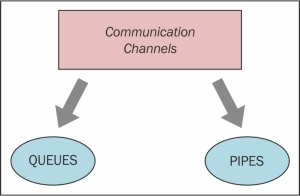The development of parallel applications has the need for the exchange of data between processes. The multiprocessing library has two communication channels with which it can manage the exchange of objects: queues and pipes.

Communication channels in the multiprocessing module
As explained before, it is possible for us to share data with the queue data structure.
A queue returns a process shared queue, is thread and process safe, and any serializable object (Python serializes an object using the pickable module) can be exchanged through it.
In the following example, we show you how to use a queue for a producer-consumer problem. The producer class creates the item and queues and then, the consumer class provides the facility to remove the inserted item:
import multiprocessing
import random
import time
class producer(multiprocessing.Process):
def __init__(self, queue):
multiprocessing.Process.__init__...


